Green Buildings in the State Portfolio
Since the issuance of the Massachusetts LEED Plus standard for state new construction and major renovation projects in 2007, Commonwealth entities have constructed a diverse range of new high-performance LEED buildings. Dormitories, hospitals, dining facilities, laboratories, science buildings, classrooms, offices, maintenance facilities, visitor centers, and others have been constructed across dozens of state agencies, public higher education campuses, airports, wastewater treatment plants, and more. These buildings include myriad strategies and technologies that have resulted in significant reductions in energy use and greenhouse gas (GHG) emissions; the installation of renewable and clean energy resources; and elements to reduce other environmental impacts, such as decreased consumption of potable water, use of less toxic finishes, and recycling of construction debris.
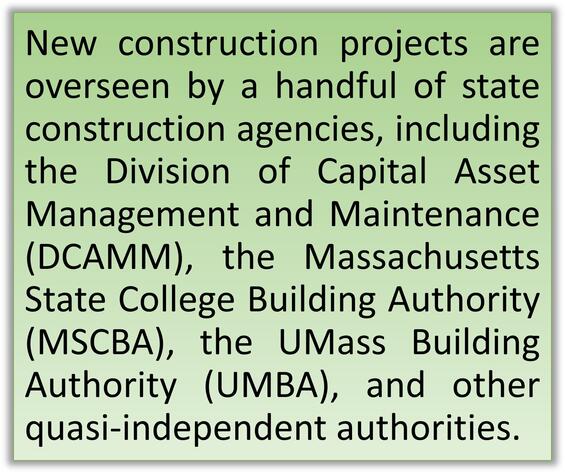
In recent years, efforts have expanded beyond LEED to target the construction of high-efficiency Zero Net Energy Buildings (ZNEBs) that generate an equivalent amount of energy from onsite renewable resources as is used by the buildings themselves.
In July 2021, LBE Executive Order 594 (EO 594) established the updated Massachusetts LEED Plus 2.0 Standard, which requires all new state buildings and major renovations to continue with 20% better than code energy performance plus additional requirements that will further reduce GHG emissions. More information on these buildings can be found on the LBE Progress & Data web page (coming soon).
Progress is also being made to make existing buildings more efficient through energy conservation measures, fuel-switching, and operational efficiencies, resulting in an overall reduction in Energy Use Intensity (EUI) across the state portfolio. More information on portfolio-wide progress on energy use reduction and green building development can be found on the LBE Progress & Data web page (coming soon).
LEED Buildings
Leadership in Energy & Environmental Design (LEED) sets building benchmarks in six design categories: sustainable sites, water efficiency, energy and atmosphere, materials and resources, indoor environmental quality, and innovation in operations and regional priority. LEED is a design-based certification and is achieved when building design meets established category thresholds for each certification tier.
As of December 2022, there are 100 LEED certified buildings at state government facilities, over two-thirds of which are certified at the Platinum and Gold levels, LEED's highest accreditations. A full list of state LEED buildings can be downloaded below.

Since 2007, all state-owned new construction over 20,000 square feet must receive LEED certification. Any newly constructed state facilities must be certified at the LEED Silver level or higher.
Additional Resources
-
Open XLSX file, 17.2 KB, List of LEED Certified State Buildings (English, XLSX 17.2 KB)
Zero Net Energy Design Buildings
Zero Net Energy (ZNE) design couples high-efficiency energy performance with onsite electricity and/or thermal generation. ZNE is achieved when an ultra-efficient building balances its energy use with equivalent onsite generation of electricity from renewable resources; ZNE design prioritizes optimized building efficiency, the avoidance of fossil fuel-based heating/cooling systems, and onsite renewable energy generation.
The ZNE building design approach often includes measures such as high-performance envelopes, reduced air infiltration, heat recovery ventilation, external shading to reduce heat gain, efficient electric heating and cooling technologies, and the integration of onsite solar generation.
There are currently five buildings in the Commonwealth's portfolio that have been completed using ZNE principles, with additional construction projects at various stages of design and construction.

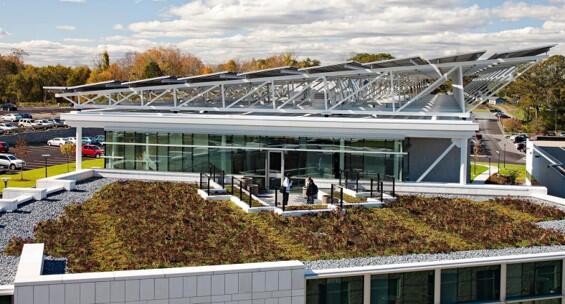
North Shore Community College Health Professions & Student Services Building
Location: Danvers
Constructed: 2011
Size: 58,000 square feet

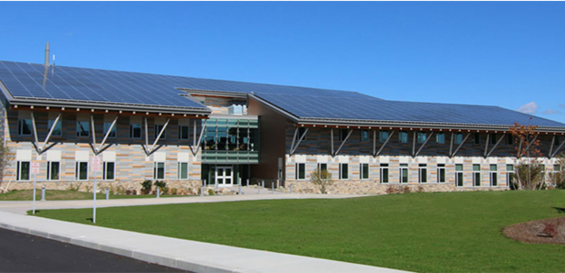
Division of Fisheries and Wildlife Field Headquarters
Location: Westborough
Constructed: 2014
Size: 45,000 square feet

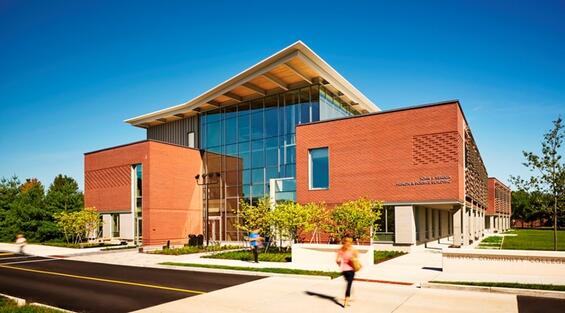
Bristol Community College Sbrega Health & Science Building
Location: Fall River
Constructed: 2016
Size: 50,600 square feet

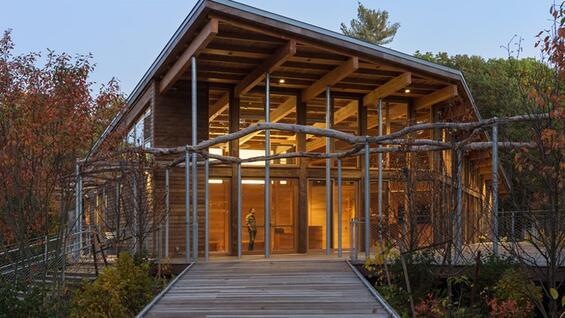
Department of Conservation and Recreation Walden Pond Visitor Center
Location: Concord
Constructed: 2016
Size: 6,500 square feet

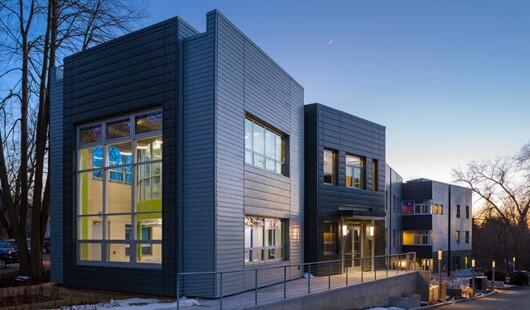
UMass Amherst Crotty Hall
Location: Amherst
Constructed: 2017
Size: 16,800 square feet

Passive House Buildings
Passive House focuses on ultra-low energy design that prioritizes building envelope efficiency to reduce the need for mechanical systems. Passive House is a performance-based certification using three criteria: ultra-low air infiltration rate, source energy use intensity (EUI), and space heating and cooling demand.
As of March 2022, there are no state facilities that are Passive House certified. However, the Massachusetts LEED Plus 2.0 Standard authorizes the use of Passive House certification as a compliance pathway.
Massachusetts LEED Plus 2.0 Standard for New Construction
For full details and implementation guidance, see the Massachusetts LEED Plus 2.0 Guideline for New Construction.
Under EO594, all state government new construction and major renovation projects over 20,000 square feet (built for state use or built on state land) must meet the requirements of the Massachusetts LEED Plus 2.0 Standard. The Standard advances high-performance construction by requiring all applicable projects to:
- Obtain LEED certification at the Silver level or higher.
- Perform 20% better than existing energy code requirements (Starting July 1, 2023, the TEDI requirements of the DOER Specialized Stretch Energy Code will replace this energy requirement).
- Use only efficient electric or renewable thermal for heating, cooling, and water heating.
- Follow a design that utilizes a best-in-class EUI target.
- Maximize onsite renewables or be solar-ready.
- Incorporate long-term climate resiliency into design and siting decisions.
- Pre-wire and install EV charging ports in new or renovated parking areas.
Reducing Energy Use in Existing Buildings
Through a variety of efforts spanning decades, state entities have been working to reduce the use of higher emitting fuels, improve the energy intensity of their facilities, and enhance operational efficiency. These entities have deployed a wide range of efficiency measures including high performance lighting and lighting controls, envelope improvements, high efficiency heating and cooling equipment, fuel switching, variable speed drives and efficient motors, and more.
The collective result of these efforts has led to the elimination of carbon-intensive fuels (such as coal and #6 oil), significant decreases in GHG emissions, and commendable reductions in energy use intensity (see progress on the LBE Progress & Data web page, coming soon).
Energy Efficiency Projects
The Division of Capital Asset Management and Maintenance (DCAMM) oversees the design and construction of the majority of efficiency projects at executive branch agencies and colleges and universities, while some projects are implemented by agencies, authorities and campuses themselves. More information about DCAMM energy projects can be found here. Wherever possible, projects strive to maximize Mass Save® incentives available from the state’s investor-owned utilities.
Operational Efficiencies
In addition to deployment of energy conservation measures and fuel switching, many state entities are also working the reduce energy use through operational efficiencies. Such efforts rely in large part on real-time energy usage platforms like the Commonwealth Energy Intelligence (CEI, detailed further down on this page). In many cases, this data has helped identify energy use reduction opportunities that once addressed resulted in immediate savings. For example, at one agency, the CEI data showed energy use spike several hours before the facility opened as building equipment started. By adjusting startup schedules incrementally over a period of time, building operators found they could delay equipment start time by over two hours without impacting performance. This new daily schedule resulted in an estimated 388,000kWh of electricity savings annually.

With building-level energy data available down to the 5-minute interval through CEI, building operators were able to visualize and quantify energy and cost savings of optimizing building equipment start times. Changing startup times with this data resulted in daily energy use reductions.
Resources
Green Buildings in the State Portfolio
- Countdown to 100 LEED Certified Buildings ⇒ Highlighting recently certified buildings as the state portfolio approaches 100 LEED certifications at its facilities.
- #91 - MassPort Hanscom
- #92 - Trial Court: Lowell Justice Center
- #93 - UMass Amherst: Isenberg School of Management
- #94 - DCR: North Point Maintenance Facility
- #95 - UMass Amherst: Worcester Commons
- #96 - MassPort: Logan Terminal B
- #97 - UMass Amherst: South College
- #98 - UMass Amherst: Student Union
- #99 - UMass Lowell: Coburn Hall
- #100 - Holyoke Community College Campus Center
- List of LEED Certified state buildings ⇒ Provides entity, building, and certification information for the 100 LEED buildings in the state portfolio.
Incentive and Funding Resources
- Mass Save Commercial New Construction and Major Renovation (as of Dec 2022) ⇒ The Sponsors of Mass Save offer comprehensive incentives and technical support to help you design a low carbon, energy-efficient building that’s comfortable, durable, and less costly to operate. View this webinar describing the incentive pathways for new construction and major renovation.
- Mass Save Deep Energy Retrofits ⇒ By participating in the Deep Energy Retrofit (DER) offering, businesses can receive additional incentives to substantially reduce greenhouse gas emissions through HVAC electrification, building shell or ventilation upgrades, and other tailored solutions.
Building Decarbonization Programs and Technical Assistance
- DCAMM Energy Team ⇒ The DCAMM Energy & Sustainability programs help facilities plan sustainable and energy efficient building projects, including LEED certification for all new construction and major renovation projects. DCAMM provides guidance on utility incentives, demand response, energy credits, and savings optimization programs, and administers funding mechanisms to support sustainable and resilient choices for the agencies it serves.
- Pathways to Zero Net Energy Program ⇒ The Pathways to Zero Net Energy Program was a $3.5 million DOER initiative designed to facilitate a transition to the next generation of high-performance buildings. Completed projects submitted case studies to the Northeast Sustainable Energy Association (NESEA) Building Energy Case Study database.
- U.S. Department of Energy Better Buildings Low Carbon Tech Strategies Toolkit ⇒ DOE's guidance documents are designed to aid owners and operators of existing buildings in planning retrofit and operational strategies to achieve deep carbon reductions. Strategies are currently available for 10 building types, with a supplement for commercial kitchen equipment. Recommendations are grouped by technology, with recommended actions categorized as either simple, intermediate, or advanced.
- Low Carbon Technologies: Strategies for Different Building Types ⇒ It is possible for most building types to get to zero carbon emissions using technologies already available on the market today. This webinar from the Department of Energy Better Buildings Solutions Center covers strategies some owners are already using – and those you could be using – to get buildings to low- and no-carbon. Speakers: Paul Torcellini, National Renewable Energy Laboratory (NREL); Kent Peterson, P2S Inc.; Stanton Stafford, Integral Group
- U.S. Department of Energy Better Buildings Webinars ⇒ Through Better Buildings webinars, experts discuss a variety of topics from Air Management to Zero Energy. These webinars are helpful resources on key subject areas in energy efficiency, water efficiency, resilience, and more. Slide decks are available for download. To sign up for an upcoming live webinar, click here.
- ASHRAE/NYSERDA Community Heat Pump Systems Webinar Series ⇒ Where applicable, a community-style thermal strategy can accelerate decarbonization of the building stock, moving from a building-by-building approach to a block-by-block and community-by-community model. The New York State Energy Research and Development Authority (NYSERDA) has partnered with ASHRAE to develop a series of 17 free webinars designed to engage and educate all stakeholders involved in community heat pump system design and implementation.
Energy Efficiency Tools and Resources
- Massachusetts Energy Insight (MEI) ⇒ This tool allows LBE partners to view current and historical energy use for multiple commodities and generates reports on energy consumption trends at the building, facility, and site level. [More details below]
- Commonwealth Energy Intelligence (CEI) ⇒ This program, managed by DCAMM, provides state facilities with access to real-time metering, building management system integration, utility bill management and building energy analytics. [More details below]
- DOER Clean Heating and Cooling ⇒ The DOER Renewable Energy Division has compiled introductory information on clean heating and cooling technologies, as well as incentives for residential, business, and government operations.
- DOER Energy Efficiency Resources and Tools ⇒ The DOER Energy Efficiency Division has compiled resources for energy practitioners, businesses, and more to help entities learn best practices and access fiscal and technical assistance.